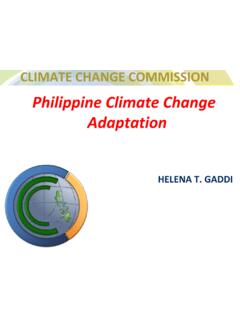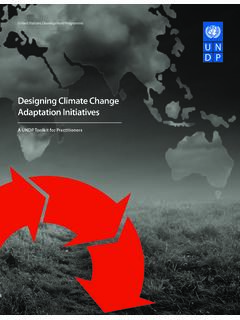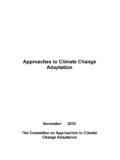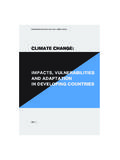Transcription of CLIMATE RESILIENCE - HUD
1 Office of Economic RESILIENCE Office of Community Planning and Development Department of Housing and Urban Development Natural disasters are occurring more frequently and are increasingly severe. All levels of government, individual households, and businesses are shouldering the high cost of disaster recovery. Communities are looking for new ways to become more resilient to these changes and challenges. Planning for severe weather and other CLIMATE changes increases the safety of neighborhoods and improves a community s ability to recover quickly after an event, reducing losses and costs. While disasters are expensive for everyone, they have the most devastating effects on low- and moderate-income families and households without the personal resources to bounce back. RESILIENCE is the result of careful planning efforts rooted in an awareness of community assets and vulnerabilities.
2 Natural hazards and CLIMATE change do not recognize political boundaries. Inter-jurisdictional collaboration and regional planning are essential to becoming resilient to a changing CLIMATE . A critical component of HUD s mission for the past 50 years has been to support planning and urban development efforts that expand opportunity for Americans. The Sustainable Communities Initiative (SCI) grants awarded in 2010 and 2011 constitute HUD s most comprehensive community and regional planning effort in decades. HUD s SCI awarded funding to 143 communities through Regional Planning Grants and Community Challenge Planning Grants, serving forty percent of residents. HUD s $250 million investment opened the door to hundreds of millions of dollars of public and private investment and engaged more than 3,300 core partner groups nationwide.
3 Barrier islands in Florida protect the coastline and infrastructure from flooding; the Seven50 Prosperity Plan, a HUD Regional Planning grant project, focused on CLIMATE RESILIENCE CLIMATE RESILIENCE PREPARING COMMUNITIES FOR THE RISKS AND OPPORTUNITIES OF A CHANGING CLIMATE HUD is committed to helping communities recover from natural disasters and be more resilient to future shocks and stresses. Most recently, in 2014, HUD launched the $1 billion National Disaster RESILIENCE Competition in order to expand opportunities for eligible states and jurisdictions to employ innovative approaches to RESILIENCE and recovery. BY THE NUMBERS $43 BILLION 37% 70% $1 Spent on mitigation saves an average of $4 in recovery costs following a natural disaster Reduction in average stream flows in major Southwestern rivers and basins since 2001 In CDBG-Disaster Recovery funds administered by HUD to states and localities to assist with recovery between 2005-2013 Increase in rainfall during heaviest storm events in the Northeastern region (1958-2010) WHAT Taking action before the next disaster to reduce human and financial consequences later Adjusting natural or human systems in a changing environment that reduces negative effects and takes advantage of opportunities CLIMATE RESILIENCE CLIMATE ADAPTATION HAZARD MITIGATION The ability to prepare for and adapt to changing conditions.
4 And to withstand, respond to, and recover rapidly from disruptions HUD Office of Economic RESILIENCE STRATEGIES FOR CLIMATE RESILIENCE HUD SCI Grantees have employed the following strategies to enhance their capacity to withstand and recover from natural disasters. The path to RESILIENCE is a progression of steps, though communities can tailor their approach depending on local needs and resources. SCI GRANTEE CASE STUDIES IDENTIFY LEADERSHIP, STAKEHOLDERS, AND DATA SOURCES CREATE A RESILIENCE PLAN CONDUCT RESILIENCE ASSESSMENT DEVELOP GOALS BASED ON ASSESSMENT IMPLEMENT RESILIENCE PLAN AND MONITOR PROGRESS BUILDING PLANNING AND INVESTMENT AROUND RESILIENCE GOALS Gulf Regional Planning Commission | Plan for Opportunity: Gulf Coast Sustainable Communities During the initial stages of their regional planning process, the Mississippi Gulf Coast Sustainable Communities Initiative realized they were missing a crucial component: RESILIENCE .
5 Much of the region lies within the 100-year floodplain, and rising sea levels will only increase the number of people at risk for significant loss during a major storm event. In Mississippi, homeowners have the fourth-highest insurance premiums in the country. Since Hurricane Katrina, wind insurance premiums have increased 90%, and many families struggle to maintain housing affordability with this added cost burden. The project team expanded their consortium to help inform a series of RESILIENCE assessments. A RESILIENCE Committee comprised of representatives from vulnerable communities evaluated the RESILIENCE of five regional systems that would be affected by major CLIMATE events: housing, transportation, economic development/workforce, water, and food. These RESILIENCE assessments identified the greatest threats and vulnerabilities of each system.
6 The resulting RESILIENCE strategies addressed potential challenges and identified responsible parties, an action timeframe, and indicators to measure progress. One strategy was the integration of hazard mitigation plans into local comprehensive plans. As the guiding instrument for land use planning and public investments, comprehensive plans play a role in reducing risk associated with developing in hazard areas. By linking the two planning processes, both yield stronger outcomes and ensure complementary objectives and actions. Jurisdictions were also encouraged to join the Community Rating System (CRS) run by the National Flood Insurance Program. The CRS rates communities based on their floodplain management and disaster preparedness, using these ratings to determine discounts in flood insurance premium rates.
7 Well-rated communities are not only more resilient to natural disasters, but also save on insurance costs. Collaborative efforts by groups like the Mississippi Alabama Sea Grant Consortium and the Southern Mississippi Planning and Development District have facilitated the participation of local governments, resulting in three new jurisdictions joining the CRS and seven existing members improving their ratings, lowering flood insurance costs for residents and businesses. The Gulf Coast learned the value of assessing all vulnerabilities and risks that could potentially disrupt essential regional systems, and the importance of having the right stakeholders at the table to develop a comprehensive plan for RESILIENCE . Learn more at: A comprehensive RESILIENCE approach along Mississippi s Gulf Coast will protect vulnerable local economies, businesses, and residents HUD Office of Economic RESILIENCE Rutgers: State University of NJ | Together North Jersey USING GREEN INFRASTRUCTURE TO BUILD RESILIENCE Together North Jersey used part of their HUD SCI grant to fund a series of Local Demonstration Projects including the award-winning Hoboken Green Infrastructure Strategic Plan.
8 The City of Hoboken is home to a disproportionate quantity of subsidized and low-income housing, and the City s most vulnerable populations are concentrated in the most flood-prone areas. This project provided a green infrastructure framework to improve the RESILIENCE of Hoboken s transit system and the surrounding communities resulting in a cost-effective approach to green and grey infrastructure to improve local stormwater management. The Hoboken Plan received the 2014 Outstanding Plan Award from the American Planning Association-New Jersey chapter. Learn more at: and see HUD s Green Infrastructure Report for more info on SCI projects that planned for green infrastructure. The State of Rhode Island has the highest ratio of shoreline per capita in the United States, leaving it highly vulnerable to sea level rise.
9 In 2014, a state-level CLIMATE change Coordinating Council was established to lead the development of comprehensive RESILIENCE strategies. Rhode Island completed a number of vulnerability assessments that will be used to set priorities for state and local planning. To help municipalities incorporate assessments into local comprehensive plans, the State released preliminary guidance based on a pilot adaptation project and is developing a Comprehensive Planning Guidance Handbook. The Rhode Island Coastal Resources Center also released a guide to help coastal businesses mitigate the effects of CLIMATE change . Rhode Island set a state precedent with the inclusion of CLIMATE RESILIENCE in their recently released Economic Development Plan, created with the support of their SCI grant.
10 The plan called for an evaluation of the economic opportunities created by CLIMATE change in addition to the risks. Technology accelerators, green infrastructure job training programs, and product research and development are a few potential niches identified. By looking at the economic opportunities of a changing environment, Rhode Island is getting ahead of the curve to anticipate products and tools that will soon be in demand as many more places adapt to CLIMATE change . Learn more at: INSTITUTIONALIZING CLIMATE MITIGATION AND ADAPTATION State of Rhode Island | RhodeMap RI The Southeast Florida Regional Partnership used its Seven50: Southeast Florida Prosperity Plan (Prosperity Plan) to frame regional priorities along six themes including CLIMATE and Energy RESILIENCE . The Prosperity Plan builds on the work of the Southeast Florida Regional CLIMATE change Compact, created by four consortium partners in early 2010, and suggests adaptation and mitigation strategies to create more resilient communities, environment, and economy.

















